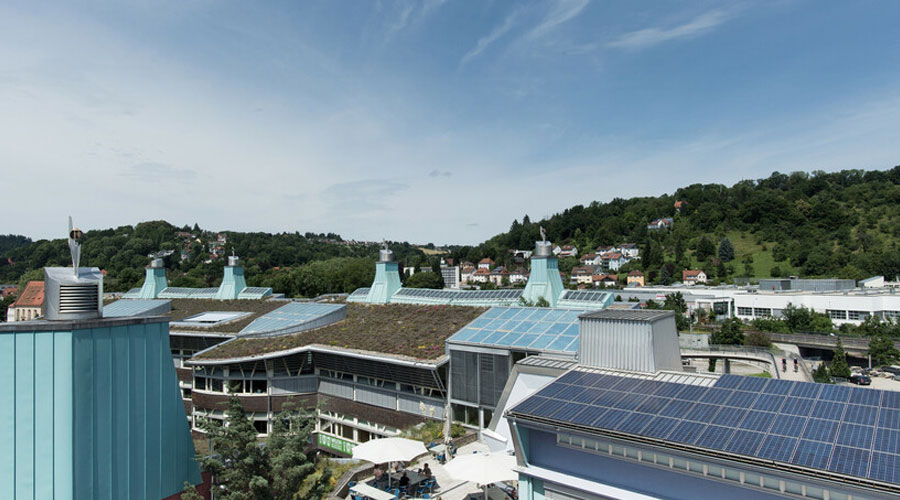
How we can protect the climate
Becoming climate neutral, one step at a time12 January 2023
What does climate neutrality mean? How can a product be climate neutral? How do you calculate a company’s carbon footprint? What can I do to improve my personal carbon footprint? Discover answers to these questions here.

Climate neutral – what does that mean?
Climate neutrality can be thought of as a balance. The emission of greenhouse gases such as carbon dioxide or methane (also called GHG emissions), must correspond to the uptake of these gases from the atmosphere into so-called carbon sinks. To achieve the goal of net zero emissions, all climate-damaging emissions must be reduced by removing the same amount of greenhouse gases from the air.Climate neutrality can be calculated, not measured
The term “climate neutral” essentially refers to a mathematical figure. In fact, there are few products or services that are inherently 100% climate neutral. Even apples from your local farmer might have been harvested by a picking machine, packed and then transported to market by tractor. All these factors add up.In this sense, climate neutral means that for a product or service, either no GHGs are produced in purely mathematical terms or exactly the same amount of GHGs is absorbed from the atmosphere as is emitted.
In other words, the transport of apples is on the debit side, while the absorption of CO₂ from the air by the apple tree is on the credit side. The bottom line should be a zero; that would then be climate neutral.
What are carbon sinks?
In the global carbon cycle, carbon sinks are particularly important. These are natural reservoirs that can absorb and store carbon, which helps to counteract climate change. Soils, forests and oceans are the Earth’s largest natural means of carbon storage. While more and more intensive work is being done on this matter, there are still no technical solutions for significant quantities of CO₂ emissions from the atmosphere.Around the world, we are contributing to the conservation of carbon sinks with our cultivation partners by managing our gardens and farmland organically. Organically managed soils are proven to store more carbon than conventionally managed soils, which is why we encourage our cultivation partners worldwide to convert to organic farming. And we actively support projects like the Borneo Orangutan Survival Foundation (BOSF), which works together with the Indonesian population to protect endangered orangutans and preserve their habitat, as well as to reforest and irrigate the tropical rainforest.

How can products or services be climate neutral?
Many companies offer climate neutral products or services. With some, like fruit or furniture, this is easy to understand. But even air travel is being advertised as climate neutral, despite the harmful emissions released when kerosene is burned to power the airplanes. For a flight to be climate neutral, an airline must offset the same amount of CO2 that escapes into the air when the fuel is burned. Many people reject the idea of a company “buying its way out” without any real improvement to its own business model, and we think they are right to do so.
How climate neutral am I?
Living a climate neutral life isn’t easy. Because it’s not just about heating, flying and driving. The Internet offers many carbon calculators to estimate your personal climate footprint, and good ideas on how to reduce your personal CO₂ emissions in everyday life, for example footprintcalculator. What should I eat? How much meat should I consume? Which electricity provider should I choose? Instead of the car, can I travel by foot, bicycle or train? How should I invest my money?Individuals can do a lot by rethinking their lifestyle and consumption habits and adopting new approaches. You can also support climate protection initiatives, of which there are many, for example, when booking a flight. They differ primarily in the quality of the projects used to offset or reduce GHG emissions. The prices for offsetting one metric tonne of CO₂ also vary accordingly. This is partly due to the type of projects supported and the country where they are located. The better certificates ensure that the measures benefit not only the climate but also the local people. One recognized and well-known seal of quality, for example, is the so-called Gold Standard.

What are CO2 equivalents?
The impact greenhouse gases have on the climate is expressed in CO2 equivalents (CO2e). Not only is carbon dioxide harmful to the climate, many other gases affect the climate, some even more profoundly. Take methane, for example: the impact of this gas, produced mainly by livestock farming, is calculated to be 25 times more harmful than CO2. The climate impact of the nitrous oxide in nitrogen fertilizers is 300 times more harmful than carbon dioxide.
324000g
CO₂ equivalents are caused on average per passenger during a short-haul flight of about 500 kilometres.*
12300g
CO₂ equivalents are caused on average by 1 kilogram of conventionally raised beef. This type of meat has the most significant impact on the climate.*
1700g
CO₂ equivalents are produced on average to make 1 kilogram of tofu. So eating tofu saves a lot in comparison to eating red meat.*
The climate footprint of a company
A company that manufactures products must purchase raw materials, process them, then package and transport the finished product to stores. All this requires energy, resources and services. When calculating a company’s climate footprint, emissions are grouped into three “scopes”:- Scope 1: Direct emissions - These are CO₂ emissions caused by the company itself, for example for process heat, through heating or driving a company car.
- Scope 2: Indirect emissions - These emissions include purchased energy like electricity and heating. They are used by the company but are generated outside of it, for example at a power plant. Scope 1 and Scope 2 emissions comprise about 1% of Weleda’s emissions.
- Scope 3: Other indirect emissions - These occur in the company’s value chain, while making and selling a product. They include emissions from the cultivation and supply of raw materials, in packaging, or during distribution or waste disposal. They also include business travel and emissions from financial investments, wage payments, commuter traffic and taxes. Scope 3 emissions are a broad category of GHG impacts over which a company usually has only an indirect influence. Scope 3 comprises about 99% of Weleda’s emissions.
"When Weleda was founded in 1921, climate change was not yet an issue – but mindful management in harmony with nature was. Today we can combine the two: a climate-positive economy and our commitment to biodiversity and healthy soils.”
Dr. Stefan Siemer, Weleda Group, Head Corporate Sustainability
What is a climate neutral company?
The term “climate neutral company” is not legally protected. However, an international standard is currently being developed to precisely define the term “climate neutrality” for transparency and accountability: ISO 14068 “Greenhouse gas management and related activities – Carbon neutrality”.Weleda assesses its emissions according to the standards of the Greenhouse Gas Protocol, an international initiative. Find out more at www.ghgprotocol.org.

Weleda has been arithmetically climate neutral for Scope 1 and 2 since 2021
Our world has changed since Weleda was founded in 1921. We face major challenges: climate change, dwindling biodiversity and resources, vast amounts of waste and high greenhouse gas emissions. Like our founders, we want to be pioneers today. Sustainability, biodiversity, soil health and climate protection are rooted in our corporate goals.The climate footprint of a company is referred to as the Corporate Carbon Footprint (CCF). Since 2021, we have been offsetting the company-related Scope 1 and 2 emissions of Weleda AG and the Weleda Group. Taking into account our reductions in 2021, these mostly energy-related emissions by all Weleda subsidiaries worldwide still amounted to around 6,600 metric tonnes of CO₂ equivalent per year. The fact that this figure is not higher has been achieved through a wide variety of measures. For instance, we use 100% renewable energy in our buildings at Weleda headquarters in Switzerland, including for energy-intensive production processes: green electricity, woodchip heat for heating, generating our own electricity through photovoltaics, geothermal energy for heating and cooling, and biogas in manufacturing.
We are also working to further improve Scope 3** of our Corporate Carbon Footprint. For example, we have continuously increased the proportion of recycled materials in our packaging, and reduced the weight of many packages by dispensing with outer packaging or package inserts. Weleda employees also contribute to these efforts personally. For over a decade, our global “Bike to Weleda” programme has promoted environmentally friendly commuting. Forgoing the use of cars to get to work, participants covered nearly 130,000 km by bicycle and on foot in 2021 alone.

Weleda products climate neutral since October 2022
The product-related part of our climate footprint, also called the product carbon footprint (PCF), for the entire Weleda Group amounted to approximately 45,000 metric tonnes of CO₂ equivalent per year (including energy) in 2021 after deducting all reductions. In addition to our company’s energy-related climate footprint, this also includes, for example, emissions from packaging, raw materials, operational waste and the transport of goods. By offsetting this amount of GHG emissions, all Weleda products have been arithmetically climate-neutral since October 2022. More on our climate-neutral products.
*Source: www.co2online.de
**According to the Greenhouse Gas Protocol (GHGP)

